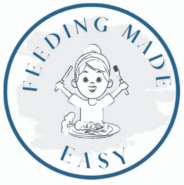Peanut allergies are the most studied food allergy. This is probably because peanuts are the most common food allergy in people under the age of 18 (1). Because of this, many of our guidelines for allergy introduction are based on research done with peanuts.
Peanut allergies are usually lifelong, but there are studies working on a treatment. Scientists are looking into oral immunotherapy, or building a tolerance to peanut protein, but currently this treatment is still in the research phase (2).
Peanuts are actually legumes, not nuts, so having a peanut allergy doesn’t mean you need to avoid all nuts. However, it is common for kids to be allergic to both tree nuts and peanuts. Peanuts are more closely related to beans, peas, lentils, and soybeans than they are to nuts.
This post may contain affiliate links and when you click on the links I may earn a small commission at no charge to you. As an Amazon affiliate, I earn a commission from qualifying purchases.
How to Introduce Peanuts
While it’s not recommended to give kids whole peanuts until age 4, early introduction of allergens has been shown to reduce the incidence of food allergies (3). It is recommended to introduce peanuts around 6 months of age, but not before 4 months of age.
As with other allergens, introduce peanuts as the only new food that day. If you are looking for a more comprehensive guide to introducing allergens, check out my Allergy Introduction Handbook. Please note that some of these suggestions include other allergens (indicated with a *).
- Smooth peanut butter mixed into baby cereal
- Bamba snack
- Smooth peanut butter thinly spread on toast* strips
- Banana muffins*
- Crushed peanuts as coating on a banana or avocado
- Smooth peanut butter diluted with breastmilk or formula
Diagnosis
The gold standard for the diagnosis of a food allergy is an oral challenge. While scary, it’s actually an easy test to perform: if the child eats the allergen, do they consistently produce a reaction? If so, they are allergic. Then, to confirm a diagnosis, a doctor may use a blood test or skin prick test. A medical professional should always make the diagnosis. A self-diagnosis can lead to unnecessary restriction.
How to Avoid Peanuts
It may not be as simple as just not eating peanuts. Peanuts can come into contact with other foods during processing. There can be cross-contact in the kitchen if the cook touches peanuts or a peanut product and then cooks another dish.
It’s very important to always check food labels. Companies must list peanuts clearly on the ingredients list in plain language or under the label in a statement that reads “Contains peanuts.”
Places to Check
Always ask about ingredients in foods that you did not make yourself. When eating at a restaurant, there is always a risk of cross-contact, so it is important to make it very clear that there is an allergy.
Some alternative nut options (such as sunflower butter) are made on shared equipment with tree nuts and peanuts. You can contact the manufacturer to determine whether these products will be safe.
Some compost uses peanut shells. If you are purchasing fertilizer, or hiring someone to do landscaping, check to make sure there are no peanut products in the fertilizer.
Other Names for Peanuts
These terms mean that peanuts may be present:
- Arachis oil
- Artificial nuts
- Beer nuts
- Cold-pressed, expelled, or extruded peanut oil
- Ground nuts
- Lupin (or lupine) – common in gluten-free foods
- Mandelonas
- Mixed nuts
- Monkey nuts
- Nut meal
- Nut meat
- Nut pieces
- Peanut butter
- Peanut flour
- Peanut protein hydrolysate
What about peanut oil?
Most people will not have a reaction to highly refined peanut oil, so it is not required to be labeled in products. You can speak with your allergist about your unique situation. Cold-pressed, expelled, or extruded peanut oils should be avoided as they can contain small amounts of peanut protein.
Reactions to Peanuts
A reaction to peanuts via the skin or air is not common. However, if a child gets peanut butter on their hands and then touches their eyes or puts their fingers in their mouths, it could cause problems.
Although reactions can range from mild to severe, it is usually recommended for all kids with peanut allergies to have an epi-pen with them at all times. Epinephrine is used to treat anaphylaxis, a severe reaction to allergies.
| Mild | Severe | |
|---|---|---|
| Skin | mild rash, some hives | widespread rash, hives all over the body |
| Face | itchy mouth, runny nose, sneezing | lip swelling, tongue swelling |
| Gastrointestinal | nausea | vomiting, diarrhea |
| Airway | none | coughing, wheezing, trouble breathing |
My Introducing Allergens Guide has information on introducing peanuts, plus the other top 9 allergens. It walks you through allergy introduction plus provides a sample meal plan and recipes.

Krystyn Parks is a Registered Dietitian and Lactation Consultant who specializes in feeding children. She has a Master’s Degree in Nutritional Science from California State University Long Beach. She is an International Board Certified Lactation Consultant and has been registered with the Commission on Dietetic Registration since 2013.
